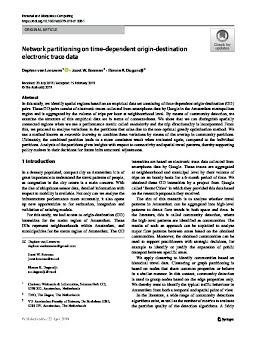2019-04-22
Network partitioning on time-dependent origin-destination electronic trace data
Publication
Publication
Personal and Ubiquitous Computing , Volume 23 p. 687- 706
In this study, we identify spatial regions based on an empirical data set consisting of time-dependent origin-destination (OD) pairs. These OD pairs consist of electronic traces collected from smartphone data by Google in the Amsterdam metropolitan region and is aggregated by the volume of trips per hour at neighbourhood level. By means of community detection, we examine the structure of this empirical data set in terms of connectedness. We show that we can distinguish spatially connected regions when we use a performance metric called modularity and the trip directionality is incorporated. From this, we proceed to analyse variations in the partitions that arise due to the non-optimal greedy optimisation method. We use a method known as ensemble learning to combine these variations by means of the overlap in community partitions. Ultimately, the combined partition leads to a more consistent result when evaluated again, compared to the individual partitions. Analysis of the partitions gives insights with respect to connectivity and spatial travel patterns, thereby supporting policy makers in their decisions for future infra structural adjustments.
| Additional Metadata | |
|---|---|
| doi.org/10.1007/s00779-019-01208-1 | |
| Personal and Ubiquitous Computing | |
| Organisation | Centrum Wiskunde & Informatica, Amsterdam (CWI), The Netherlands |
|
van Leeuwen, D., Bosman, J., & Dugundji, E. (2019). Network partitioning on time-dependent origin-destination electronic trace data. Personal and Ubiquitous Computing, 23, 687–706. doi:10.1007/s00779-019-01208-1 |
|

